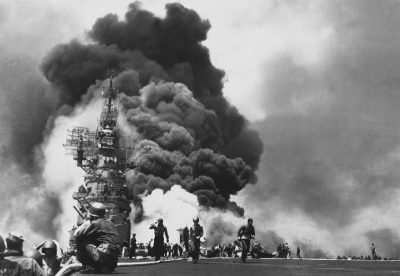The Battle of Leyte Gulf (Filipino: Labanan sa Look ng Leyte, lit.'Battle on the Bay of Leyte'; Japanese: , romanized: Reite oki Kaisen, lit.'Leyte Open Sea Naval Battle') was the largest naval battle of World War II and by some criteria the largest naval battle in history, with over 200,000 naval personnel involved. It was fought in waters near the Philippine islands of Leyte, Samar, and Luzon from 23 to 26 October 1944 between combined American and Australian forces and the Imperial Japanese Navy (IJN), as part of the invasion of Leyte, which aimed to isolate Japan from the countries that it had occupied in Southeast Asia, a vital source of industrial and oil supplies.
By the time of the battle, Japan had fewer capital ships (aircraft carriers and battleships) left than the Allied forces had total aircraft carriers, which underscored the disparity in force strength at that point in the war. Regardless, the IJN mobilized nearly all of its remaining major naval vessels in an attempt to defeat the Allied invasion, but it was repulsed by the US Navy's Third and Seventh Fleets.
The battle consisted of four main separate engagements (the Battle of the Sibuyan Sea, the Battle of Surigao Strait, the Battle off Cape Engao, and the Battle off Samar), as well as lesser actions.It was the first battle in which Japanese aircraft carried out organized kamikaze attacks, and it was the last naval battle between battleships in history. The Japanese Navy suffered heavy losses and never sailed in comparable force thereafter since it was stranded for lack of fuel in their bases for the rest of the war and so it could not affect the successful Allied invasion of Leyte.
Kamikaze (神風, pronounced [kamiꜜkaze]; "divine wind" or "spirit wind"), officially Shinpū Tokubetsu Kōgekitai (神風特別攻撃隊, "Divine Wind Special Attack Unit"), were a part of the Japanese Special Attack Units of military aviators who flew suicide attacks for the Empire of Japan against Allied naval vessels in the closing stages of the Pacific campaign of World War II, intending to destroy warships more effectively than with conventional air attacks. About 3,800 kamikaze pilots died during the war, and more than 7,000 naval personnel were killed by kamikaze attacks.Kamikaze aircraft were essentially pilot-guided explosive missiles, purpose-built or converted from conventional aircraft. Pilots would attempt to crash their aircraft into enemy ships in what was called a "body attack" (tai-atari) in aircraft loaded with bombs, torpedoes or other explosives. About 19% of kamikaze attacks were successful. The Japanese considered the goal of damaging or sinking large numbers of Allied ships to be a just reason for suicide attacks; kamikaze was more accurate than conventional attacks and often caused more damage. Some kamikazes were still able to hit their targets even after their aircraft had been crippled.
The attacks began in October 1944, at a time when the war was looking increasingly bleak for the Japanese. They had lost several important battles, many of their best pilots had been killed, their aircraft were becoming outdated, and they had lost command of the air. Japan was losing pilots faster than it could train their replacements, and the nation's industrial capacity was diminishing relative to that of the Allies. These factors, along with Japan's unwillingness to surrender, led to the use of kamikaze tactics as Allied forces advanced towards the Japanese home islands.
The tradition of death instead of defeat, capture, and shame was deeply entrenched in Japanese military culture; one of the primary values in the samurai life and the Bushido code was loyalty and honor until death. In addition to kamikazes, the Japanese military also used or made plans for non-aerial Japanese Special Attack Units, including those involving Kairyu (submarines), Kaiten human torpedoes, Shinyo speedboats and Fukuryu divers.

1944Oct, 21
World War II: The first kamikaze attack. A Japanese fighter plane carrying a 200-kilogram (440 lb) bomb attacks HMAS Australia off Leyte Island, as the Battle of Leyte Gulf began.
Choose Another Date
Events on 1944
- 10Apr
Auschwitz concentration camp
Rudolf Vrba and Alfréd Wetzler escape from Birkenau death camp. - 13Apr
Soviet Union
Diplomatic relations between New Zealand and the Soviet Union are established. - 26Jun
RAF
World War II: San Marino, a neutral state, is mistakenly bombed by the RAF based on faulty information, leading to 35 civilian deaths. - 26Aug
Charles de Gaulle
World War II: Charles de Gaulle enters Paris. - 31Dec
Nazi Germany
World War II: Hungary declares war on Nazi Germany.

 English
English  español
español  français
français  português
português  русский
русский  العربية
العربية  简体中文
简体中文 